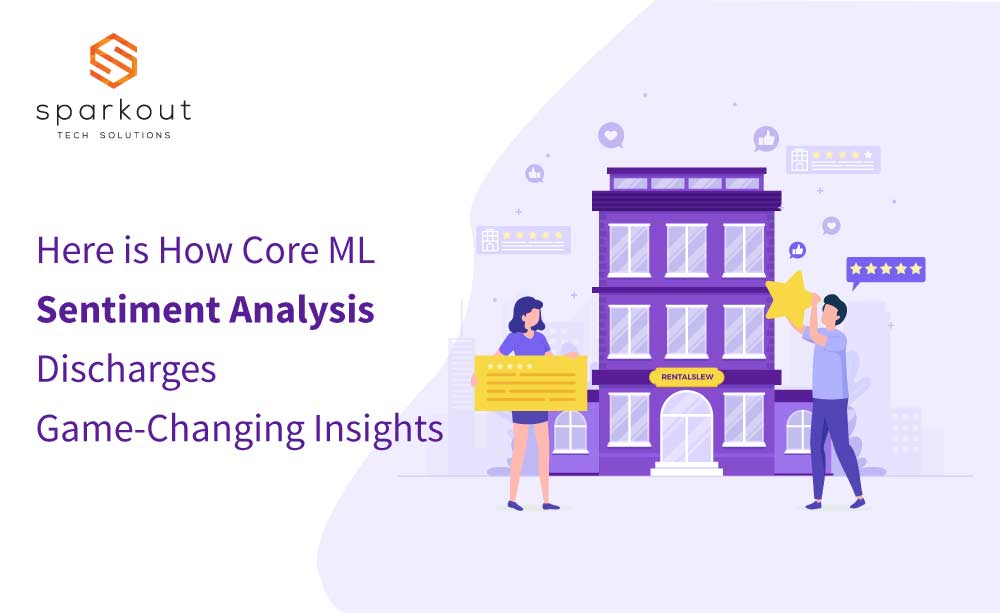
Gauging the mood of the public is crucial to know how your services fare in the industry. It provides insights on the public opinion behind certain topics which can be game changing to your brand’s trajectory. Industries use the analysis to know what the public think and expect from them and plan accordingly to increase sales and improve services.
Supplementing Core ML Sentiment Analysis into online vacation rental business allows you to scrutinize and conduct in-depth research of what travellers think about the properties, with which you can determine and renew your approach and propel your company in the right direction.
What is Sentiment Analysis?
Sentiment analysis is the process of decoding verbal content to determine whether the piece is positive or negative or neutral. It is a combination of natural language processing and machine learning techniques to decode the nuances of written language to determine the opinion of the public.
The Voice of Your Customers
Providing your customers the best experiences, of course, increases revenue and retention. But as a business owner, you ought to deal with hosts who, even after the verification, provide properties when it is not at its best; or something which the host thought was perfect but wasn’t be ample for your customers. And the customer shouldn’t be put to adjust to what is available, even if he does, he is going to opt for another company the next time. So how can you prevent that from happening?
By analysing reviews, sentiment analysis provides you with the right information on whether the customers are satisfied and happy with the service. You can then dig deeper to see where it went wrong to rectify the errors.
Knowing the voice of your customer also allows you to strategize on your customers’ needs and improve your business substantially.
How Sentiment Analysis Works?
The algorithm fused with the program separates the text into its components parts: paragraphs, sentences, phrases, words, and parts of speech. Then the words that bring out the sentiments (good, bad, worse, best, comfortable…) are identified. The words are then assigned with sentimental value, that is, if ‘mediocre’ is scored 1, then ‘bad’ is 2, ‘worse’ and ‘terrible’ are scored 3 and 4 respectively.
Summing the values of the mixture of positive and negative toned phrases, the algorithm determines whether the public opinion on the brand is good or bad or somewhere in the middle.
What is a Sentiment Library?
Similar to how we, humans, identify the seriousness of a dialogue with the tone and visual cues, the sentiment analysis requires a library with which it can refer and determine the sentiment weight of the content.
A Sentiment Library is a humongous collection of sentiment words scored and ranked by a team of coders manually. The library has to be structured with ultimate care for the definition of ‘good’ – every other word for that matter – differs with everyone.
Further, facilitating sentimental analysis in multiple languages enables you to read the brand’s image in various language-specific regions of the world.
1st Sentiment Dive: Parts of Speech
Yes, it sounds elementary, but it is one of the deciding factors to arrive at the final sentimental weight.
Parts of Speech tagging again divides the sentence and identifies nouns, verbs, adjectives, and adverbs to identify emotion value attached to the sentences. It helps the algorithm by narrowing the search to determine the total weight of the comments efficiently.
Review: Amazing place, but the lights are not bright enough.
‘Amazing’ is an adjective that describes the noun ‘place’ adding positive points, meanwhile, ‘not bright’ is dotting the negatives.
2nd Sentiment Dive: Negations
People use negations in their speech all the time, and often, it reflects in reviews too.
Review: The coastal view was great. The property wasn’t half bad either.
The above review literally states that the property was better than expected. But the subtle difference can be tricky for the algorithm to detect. The comment could be completely ignored, or worse, the comment can be taken in the negative sense which can wrongly affect the sentiment weight.
3rd Sentiment Dive: Multi-layered Analysis
Multi-layered analysis categorizes a multifaceted review to assign points for the category based on their importance and relevancy.
Review: The place amazing, but the lights are not bright enough.
In this case, it wouldn’t be fair to score ‘amazing’ with 1 and ‘not bright’ with ‘-1’. The thing is, the tenants actually loved the place as they think it is amazing. One of the features of the place wasn’t up to their expectations. Overall, if the place gets ‘1’, then lighting contribute to ‘0.1’, ambiance ‘0.1’, location ‘0.1’, among others.*
*The numbers used are for illustrative purposes only.
By dissecting the phrases and categorizing them according to their inclination towards the amnesties/features, a right sentiment can be arrived at.
Machine Learning’s Accuracy
With machine learning, coders can feed tons of reviews for the algorithm to learn to identify nouns, adjectives, adverbs, and finally, the voice of the user. Even the puns and sarcasm in the reviews can be identified with machine learning’s integration.
Almost all of the languages have words that differ in meaning with respect to the context. The AI can decode the subtle differences in the words and refine the sentiment analysis outcome.
If it is just one review, you can take a minute off, read it, and know if it is good or bad and where you need to work, but you cannot possibly scour through thousands (at the least) of reviews and know what everyone is expressing. With Sentiment Analysis, you take every review into account before the final opinion is materialized.

